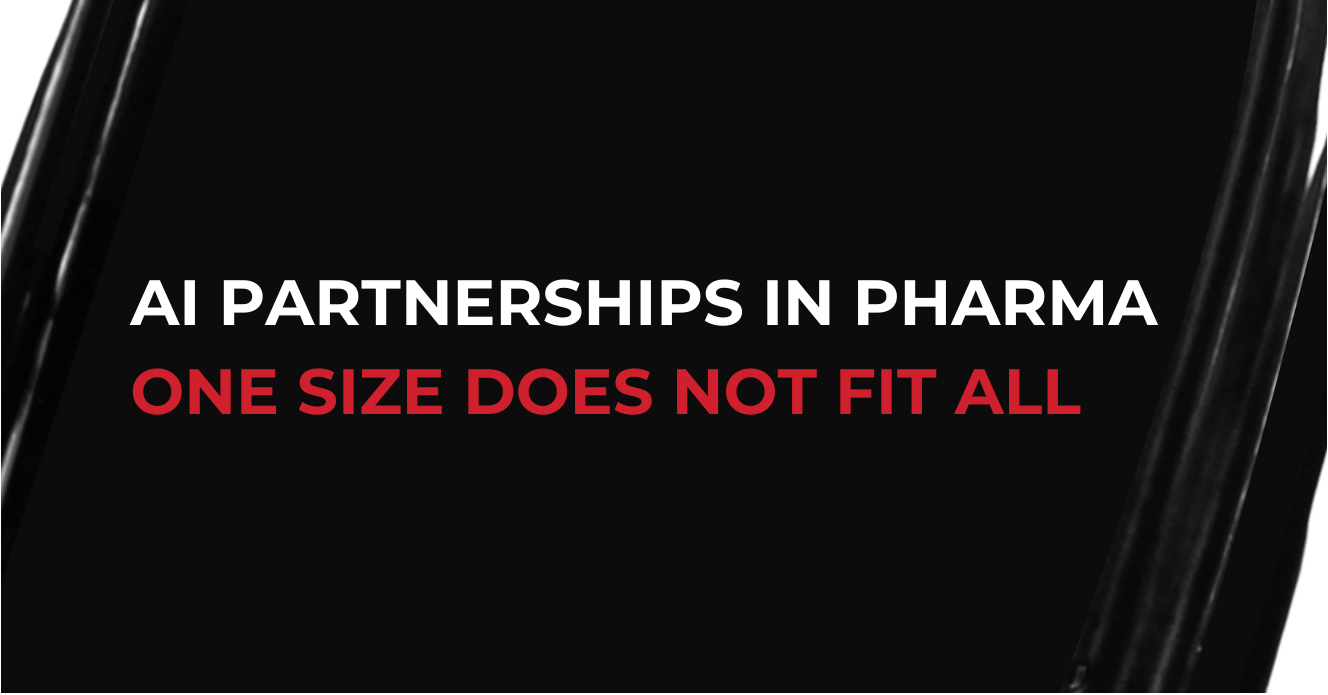From R&D to Supply Chain: How Pharma Decides to Build, Buy, or Partner on AI

AI is no longer just a buzzword in pharma — it’s becoming an operational reality. But while the industry as a whole is moving toward greater adoption, not every function is embracing AI partnerships in the same way.
In our recent research with senior leaders from more than 40 pharma, big tech, and health tech companies, we found that the decision to build AI in-house, buy an existing solution, or partner with an external provider depends heavily on where you sit in the value chain and the stakes involved.
Four Functions, Four Mindsets
While every pharma company is structured differently, most can be grouped into four primary functions, each with a distinct approach to AI adoption:
1. Early R&D
AI is streamlining time-intensive scientific work like literature review, hypothesis generation, and protein design — compressing processes that once took years into months. The biggest near-term returns aren’t from discovering entirely new drugs yet, but from strengthening the operational backbone of drug discovery.
2. Clinical R&D
A high-opportunity, high-barrier environment. AI can improve site feasibility, trial design, patient recruitment, and real-world evidence analysis. But with proprietary, regulated data at the core, trust in external partners is critical, and even small risks can halt adoption.
3. Commercial & Market Access
These profit-oriented teams are generally more open to partnerships, using AI for competitive intelligence, market access strategy, and KOL management. However, established vendor relationships mean newcomers must show clear advantages to win trust.
4. Manufacturing & Supply Chain
Typically the most risk-averse, these functions focus on process optimization and data standardization. While transformational AI use cases are rare today, the untapped opportunity for impact is significant.
Why This Matters for Pharma Leaders
For pharma executives, the opportunity — and challenge — lies in striking the right balance between quick wins and long-term transformation. The most effective leaders are directing AI investment toward operational use cases that can deliver measurable returns today, such as lab automation or market intelligence, while still placing strategic bets on future breakthroughs like AI-enabled therapeutics.
Partnership models need to be tailored to the risk tolerance of each function. Clinical and manufacturing teams, with their high stakes and regulatory constraints, require more stringent oversight and carefully chosen collaborations. In contrast, commercial teams can move faster and experiment more freely, creating opportunities for rapid proof-of-concept wins.
Finally, leaders who are seeing the most success are elevating cross-functional AI champions — individuals who can bridge R&D, clinical, and commercial silos, share learnings, and accelerate adoption across the enterprise. This kind of leadership is essential for moving from isolated experiments to enterprise-wide impact.
Why This Matters for AI Entrepreneurs
For AI founders, the message from pharma is clear: trust is earned, not assumed. In high-stakes areas like clinical development, data sensitivity, explainability, and regulatory alignment are table stakes. Startups that come to the table with transparent models, published validation, and clear guardrails will have a far better chance of breaking through.
Many pharma teams expect vendors to demonstrate results before granting access to their internal data. That means entrepreneurs should design solutions that can deliver value with limited integration upfront — and use those early wins to earn the right to deeper collaboration.
Just as important, solutions must fit seamlessly into complex workflows. Even the most promising AI product can stall if it creates friction for the teams expected to use it. Minimizing disruption and showing a low-lift path to adoption can turn cautious interest into active partnership.
As Dr. Jared Saul, Chief Medical Officer at AWS, put it:
“Decision making around clinical trial advancement is a top priority. If there’s a solution that bends the needle even a few percentage points, that’s a huge impact.”
This snapshot is just one part of a bigger picture. Our AI Pharma Report dives deeper into how pharma is making AI investment decisions, where the most promising opportunities lie, and how both executives and entrepreneurs can bridge the gap between potential and impact.
Read the full report to see how AI is reshaping pharma and where your next opportunity might be.

.png)

.png)
